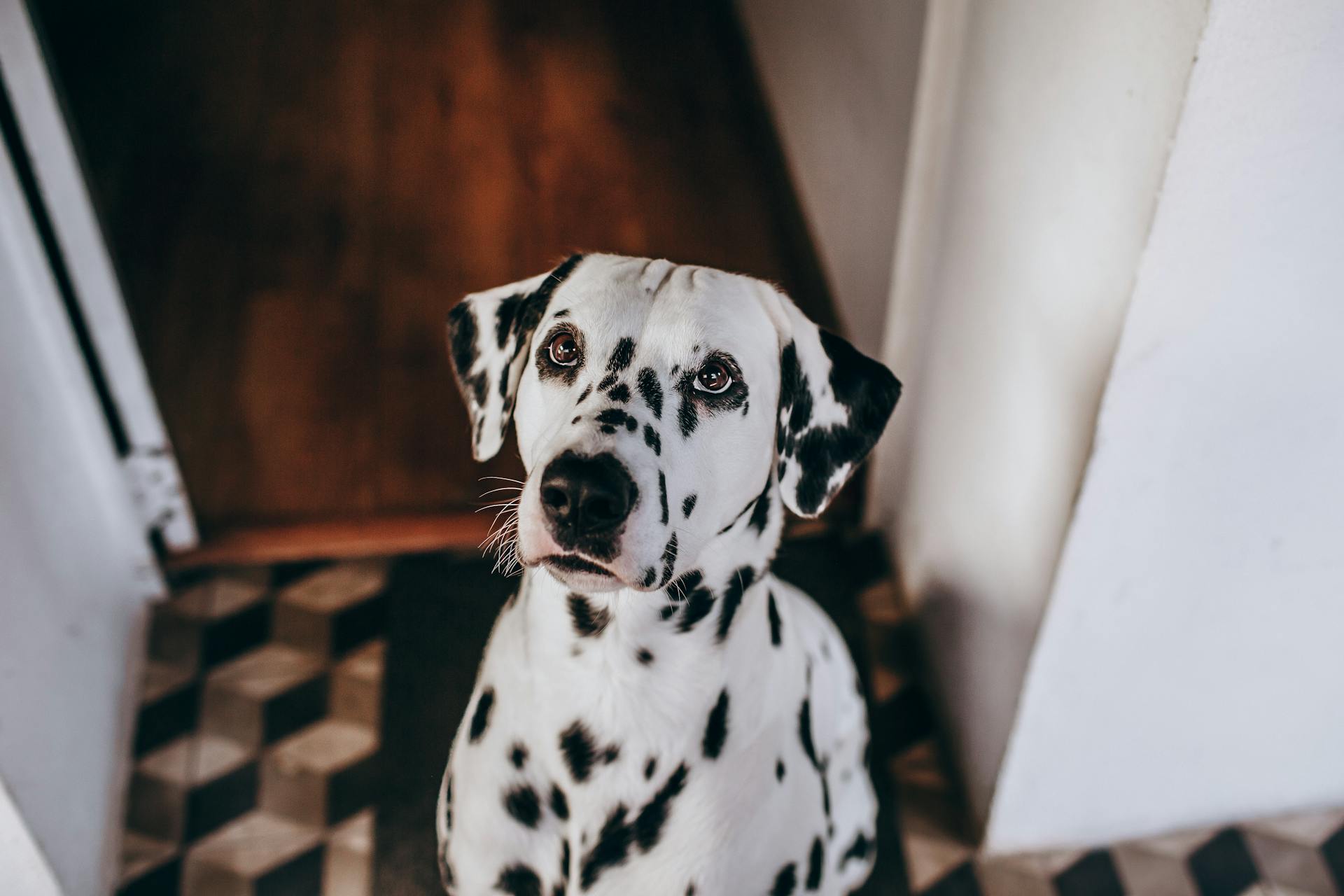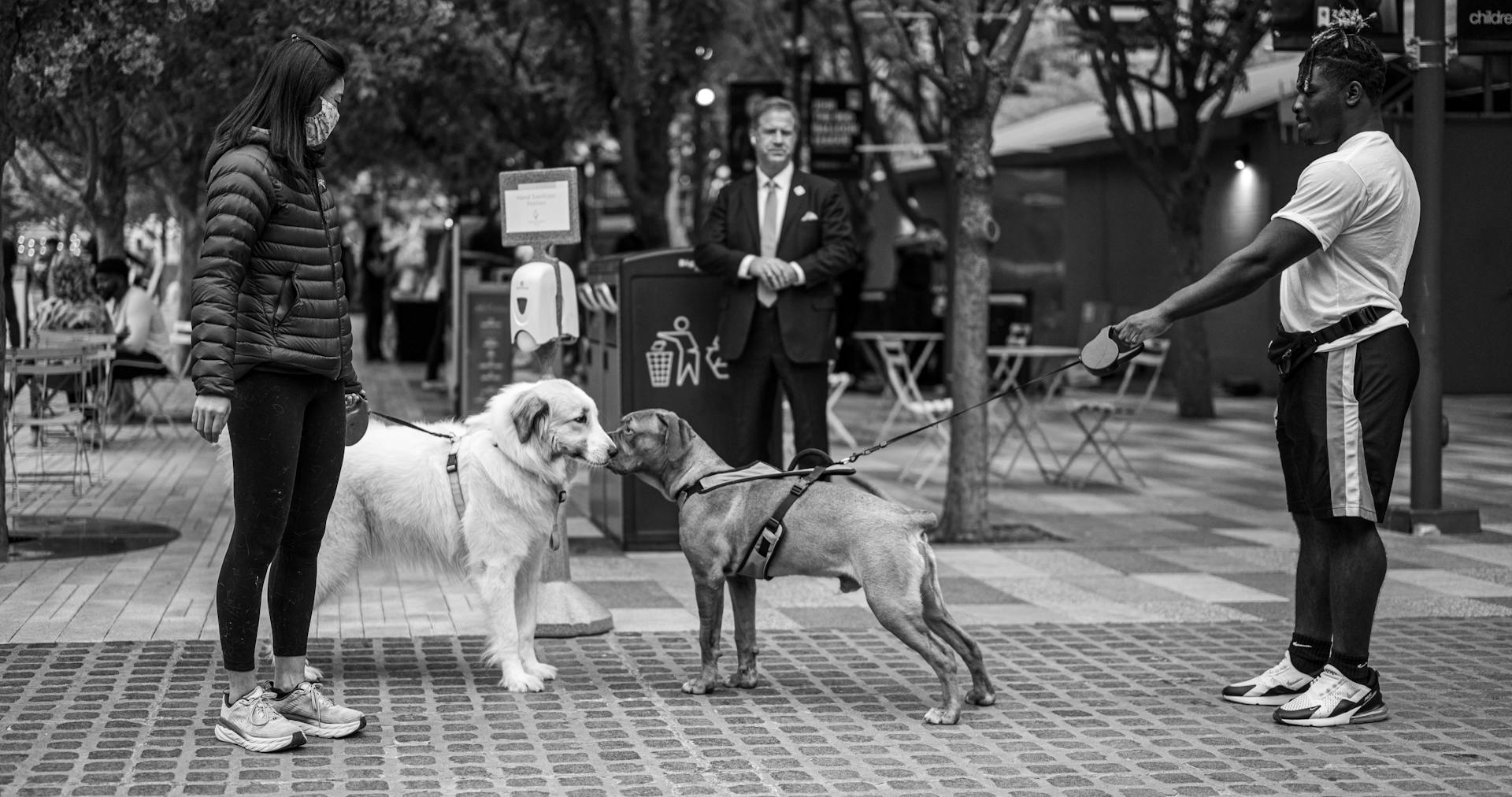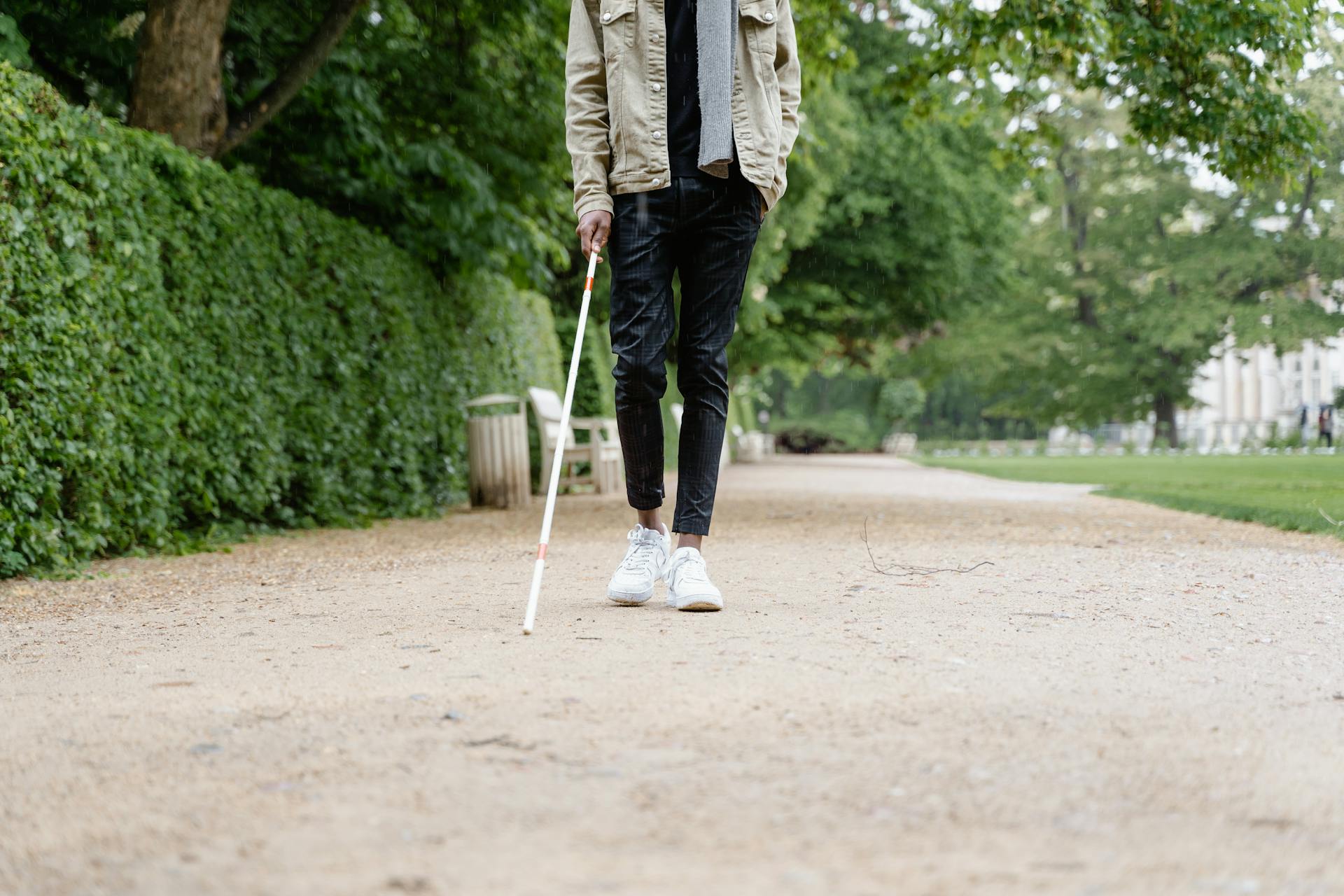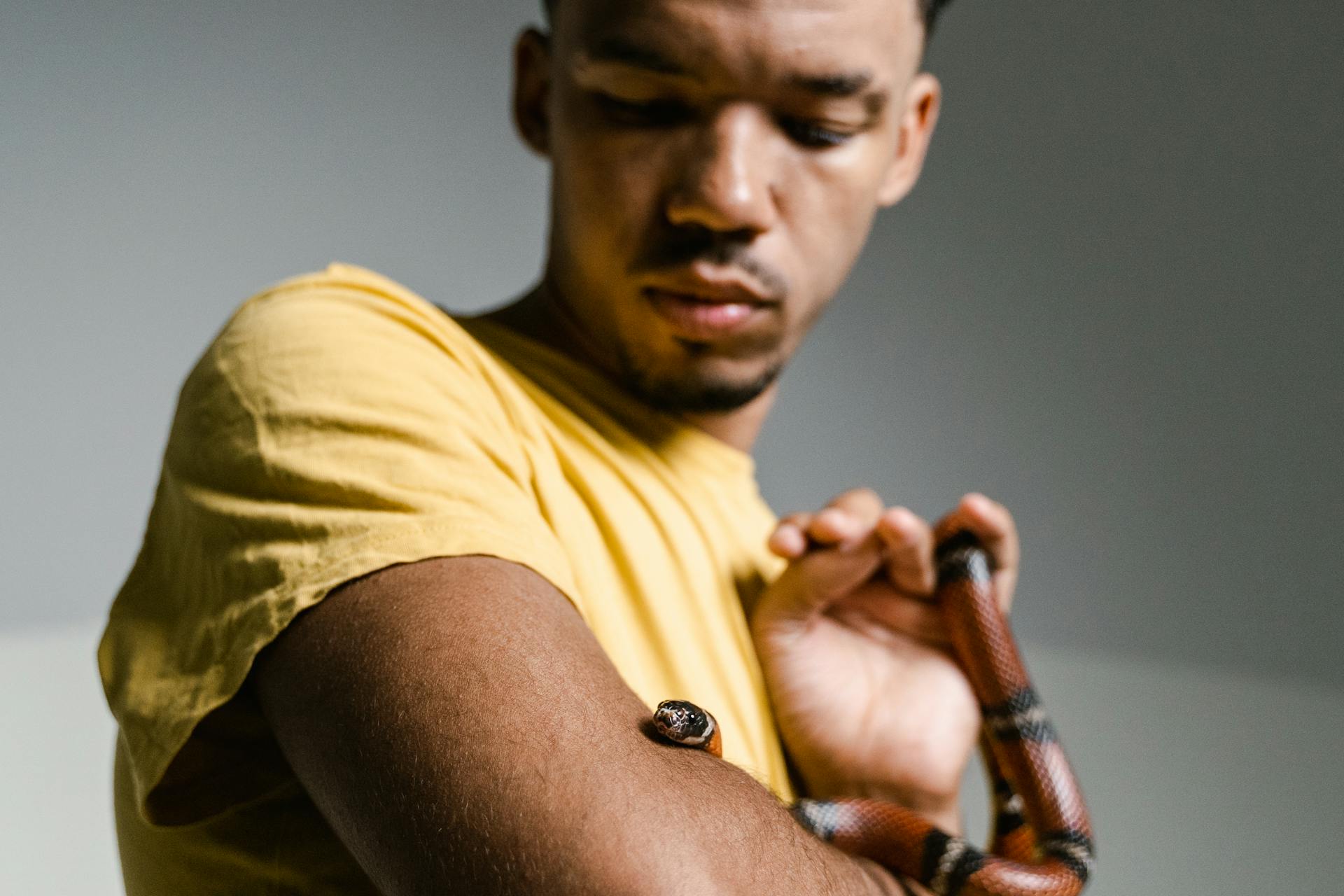
Overcoming a fear of dogs can be a challenging but ultimately rewarding experience. According to research, exposure therapy is a highly effective technique for reducing fear of dogs, with studies showing that 70% of participants experienced significant improvement after just a few sessions.
It's essential to start small and work up to more significant interactions with dogs. For example, begin by simply observing dogs from a safe distance, then gradually increase your proximity over time. This will help your brain become comfortable with the presence of dogs.
As you become more confident, try to focus on the positive aspects of dogs, such as their friendly nature and ability to provide companionship. Remember, dogs are social animals that thrive on interaction and affection.
By taking things at your own pace and practicing relaxation techniques, such as deep breathing and visualization, you can learn to manage your fear of dogs and develop a more positive relationship with them.
Understanding Fear of Dogs
Cynophobia is a specific phobia that can be caused by a mix of genetics, personal history, and environmental factors. People who have anxiety disorders or mental illnesses are more likely to develop a phobia.
Research suggests that many people who have a fear of dogs developed that fear when they were younger, often due to a scary experience with a dog or another animal. This can be triggered by a photo, story, or even just being in the presence of a dog.
If you experience symptoms such as rapid heartbeat, sweating, or avoidance of dogs, you may have cynophobia. It's essential to understand that avoiding dogs completely is almost impossible, as there are over 60 million dogs in the United States alone.
Understanding that your fear is rooted in your brain's emotional layer, also known as the limbic system, can help you relate to your dog's experience under stress. The limbic system is present in all mammals, including humans and dogs, and is responsible for processing emotions.
The good news is that cynophobia can be overcome with the help of a professional therapist. Cognitive Behavioral Therapy (CBT) and exposure therapy are effective treatments that can help you regain control of your emotions when in the presence of dogs.
A fresh viewpoint: Why Do Dogs Attack When They Sense Fear
What Is a Phobia?
Phobias are anxiety disorders that cause people to be afraid of a situation or object that is usually harmless. They involve excessive fear of an event or situation that won’t necessarily cause harm in reality.
People with specific phobia disorders have extreme reactions to a certain object or situation. They do whatever they can to avoid the thing that causes discomfort, concern or fear.
A phobia tends to have unexpected reactions to things other people don’t find scary or worrisome.
What Causes?
Phobias, including cynophobia, are complex and can't be attributed to a single factor. Genetics play a role in the development of phobias.
People who have anxiety disorders or mental illnesses are more likely to develop a phobia. A scary experience with a dog or another animal can make someone more vulnerable to developing cynophobia.
Fear and Anxiety in Dogs: A Biological Perspective
Dogs have emotions, just like humans and other mammals. This is a well-established biological fact.
The brain of a dog has three separate layers, each with a different function. The base layer, also known as the Reptilian Brain, oversees auto-motor functions like shivering and standing body hair.
The limbic system, the emotional layer of the brain, is present in all mammals, including dogs. This system is responsible for emotions like fear and anxiety.
The FEAR system in a dog's brain is designed to minimize the probability of bodily destruction. This system is a vital part of a dog's emotional experience.
The internal experience of fear and anxiety in dogs is identical to that of humans. This is why understanding the biological underpinnings of fear and anxiety in dogs is so important for relating to their experience under stress.
The book Affective Neuroscience by Jaak Pankseep, 2004, and Behave by Robert M. Sapolski, 2017, are excellent resources for learning more about the biological basis of emotions in dogs.
About This Article
Being afraid of dogs is a common phobia that can be overcome with the right techniques. You can start by learning relaxation techniques, such as deep breathing, to calm yourself down when you're near a dog.
To practice deep breathing, try taking one slow deep breath in through your nose while counting to 4, holding your breath while counting to 7, and then exhaling through your mouth and counting to 8. This can help reverse hyperventilation and calm your nerves.
Developing an exposure plan is also key to overcoming your fear of dogs. Start by reading about dogs and getting comfortable with the idea of being around them. Once you're comfortable with that, you can move on to looking at photos of dogs.
Assessing and Overcoming Fear
If you've developed a fear of dogs, understanding the extent of your fear is the first step to overcoming it. Consider your personal history with dogs, as many people who have a fear of dogs developed that fear when they were younger.
Analyzing your symptoms is also crucial, as specific phobias, including cynophobia, may include symptoms like rapid heartbeat, sweating, or avoidance of dogs. Think about when you experience these symptoms - do you need to be in the presence of a dog, or can a photo or story of a dog trigger them?
Determine if you change your life because of your fear, as avoiding dogs can be challenging, especially with over 60 million dogs in the United States alone. If you do things to avoid being around dogs, it's likely you have cynophobia.
Steps to Assessing Your Fear
Keep in mind that overcoming your fear of dogs will take work and patience, but it's possible with the right approach. Seeking help from a professional therapist can be beneficial, as they can use techniques like Cognitive Behavioral Therapy (CBT) and exposure therapy to help you overcome your fear.
Assessing Fear
If you've had a fear of dogs since you were younger, it may be the reason for your current fear of dogs. Many people who have a fear of dogs developed that fear when they were younger.

Consider your personal history with dogs to understand the root of your fear. Think about any traumatic experiences you may have had with dogs in the past.
Analyze your symptoms to see if they align with those of cynophobia. Do you experience anxiety or panic when you're near a dog, or can a photo or story of a dog trigger your symptoms?
If you find yourself avoiding dogs or situations where you might encounter dogs, it may be a sign that you have cynophobia. Over 60 million dogs are in the United States alone, so avoiding them completely is almost impossible.
Here are some common symptoms of cynophobia to look out for:
- Anxiety or panic when near a dog
- Triggered symptoms by a photo or story of a dog
- Fear of barking, but not of a silent dog
If you've determined that you have cynophobia, don't worry - there is a way to overcome this fear. It may take patience and work, but it is possible to overcome your fear of dogs.
Confronting Fears
Confronting fears is a crucial step in overcoming them. Exposure therapy is the preferred treatment for cynophobia, and it involves gradually facing the feared object or situation in a safe and predictable environment.
Avoiding triggers only perpetuates the fear, making it harder to overcome. By confronting the fear, you can learn to desensitize yourself and regain control over your emotions.
Exposure therapy can be adapted to various situations, including working with a fearful dog. The goal is to gradually build confidence, allowing the person to handle more frequent and longer exposures to the feared situation.
Here are the steps to follow in exposure therapy:
- Start with the least threatening situation and work up to more challenging ones.
- Gradually increase the duration and frequency of the exposure.
- Seek support from a therapist or a trusted individual.
Remember, overcoming fear takes time and patience. It's essential to be kind to yourself and acknowledge small victories along the way.
A certificate or a reward, like a superhero cape, can serve as a motivator to help you stay on track. The key is to find a system that works for you and to be consistent in your efforts.
Exposure Therapy and Treatment
Exposure therapy is a type of therapy that helps people overcome their fear of dogs. It involves gradually exposing yourself to dogs in a controlled and safe environment.
To start exposure therapy, you need to develop a plan that outlines each step you'll take to become comfortable around dogs. This plan should include small steps, such as watching dogs through a window or from a distance, and gradually increasing the level of exposure.
It's essential to have a trusted friend with a well-trained and calm dog to help you with exposure therapy. You should talk to the dog's owner in advance to explain your plan and ensure they're comfortable with helping you.
Exposure therapy typically involves a hierarchy of exercises, such as:
- Closing your eyes and imagining an encounter with a dog.
- Seeing pictures or videos of dogs.
- Holding a toy dog.
- Watching dogs play from a distance and slowly getting closer to the dog.
- Petting a dog while it's on a leash.
- Spending time with a dog off of a leash.
You should practice relaxation techniques, such as deep breathing and visualization, to help manage your anxiety during exposure therapy. It's also essential to reward yourself for small victories and celebrate your progress.
Exposure therapy can be done with the help of a mental health professional, a handler, and a well-trained dog. The handler should be calm, respectful, and willing to go at your pace.
Education and Awareness
Education and awareness are key to overcoming fear of dogs. This is because people are often afraid of things they don't understand.
Dog trainers and behavior consultants are well-suited to educating people about how dogs communicate and when it's safe to interact. They can teach kids to respect dogs and to recognize dog body language signals that say, "I'm uncomfortable" or "I need space."
We need to teach kids to avoid an unpleasant interaction with a dog, or worse, a dog bite. This is just like teaching them to look both ways before crossing the street.
Children should also know how to "Be a Tree", which means staying calm and still if a dog approaches them. This can help prevent a dog from feeling threatened or scared.
By educating ourselves and others about dog behavior and body language, we can reduce fear and increase understanding. This can lead to more positive interactions between people and dogs.
Diagnosis and Treatment Options
Diagnosis is a crucial step in getting over a fear of dogs. To be formally diagnosed with cynophobia, you must have experienced symptoms for six months or longer.
You can start by keeping a personal journal to track your symptoms and share with your doctor. This will help your doctor understand the impact of your fear on your daily life.
Your doctor will likely ask you questions about your symptoms and psychiatric and social history to confirm the diagnosis. If you've noticed your fear of dogs is severe and irrational, and it's affecting your daily life, you may fit the diagnostic criteria set by the DSM-5 for a specific phobia.
Here are some questions to ask yourself to determine if you might have cynophobia:
- Do I excessively anticipate situations in which I’m going to be around dogs?
- Do I immediately feel fear or have a panic attack while I’m around dogs or think about being around dogs?
- Do I recognize that my fear of dogs is severe and irrational?
- Do I avoid situations in which I may encounter dogs?
The good news is that most people with a phobia of dogs get better with therapy. But the outlook depends on the severity of the phobia and the person’s overall mental health.
How Providers Treat

Providers use a variety of techniques to treat cynophobia, a fear of dogs. Exposure therapy is a common approach, where you're gradually exposed to dogs in a controlled environment.
Exposure therapy can involve imagining an encounter with a dog, seeing pictures or videos of dogs, holding a toy dog, watching dogs play from a distance, petting a dog on a leash, or spending time with a dog off-leash. These steps help you become less fearful over time.
Cognitive behavioral therapy (CBT) is another effective treatment, which helps you change your response to fear and think about dogs in a different way. This therapy can be used in conjunction with other techniques.
Some therapists also use guided relaxation exercises, such as hypnotherapy, to help you manage your anxiety. Additionally, mindfulness exercises, yoga, breathing exercises, and meditation can be used to control anxiety.
Here are some examples of therapy techniques used to treat cynophobia:
- Closing your eyes and imagining an encounter with a dog.
- Seeing pictures or videos of dogs.
- Holding a toy dog.
- Watching dogs play from a distance and slowly getting closer to the dog.
- Petting a dog while it’s on a leash.
- Spending time with a dog off of a leash.
Medications can also be prescribed to treat depression, relieve anxiety, or control panic attacks.
How Healthcare Providers Diagnose

To get a diagnosis for cynophobia, also known as a fear of dogs, you'll need to make an appointment with your healthcare provider. They'll ask you questions about your symptoms, including when they occur and how they affect your daily life.
Your provider will likely ask about your history, including any scary experiences you've had with dogs or other animals. They may also ask about your family history of phobias.
To be formally diagnosed with cynophobia, you must have experienced your symptoms for at least six months. This is a key factor in the diagnosis process.
Your provider may refer you to a mental health professional who specializes in phobias. This expert will be able to help you work through your fear and develop a treatment plan.
Here are some questions to ask yourself to see if you might fit the diagnostic criteria for cynophobia:
- Do I excessively anticipate situations in which I’m going to be around dogs?
- Do I immediately feel fear or have a panic attack while I’m around dogs or think about being around dogs?
- Do I recognize that my fear of dogs is severe and irrational?
- Do I avoid situations in which I may encounter dogs?
What Is the Prognosis for People Who Have?
People with cynophobia, a fear of dogs, can see improvement with therapy, but the outlook depends on the severity of the phobia and the person's overall mental health.
Some people may need long-term therapy for the condition to improve, and in some cases, a combination of therapies is necessary.
Most people with cynophobia get better with therapy, making it a promising treatment option.
When to See a Healthcare Provider

If you or your child has severe signs of cynophobia, it's essential to talk to your provider right away.
Many kids are afraid of dogs when they're young, and it's common to outgrow this fear. However, if your child's fear is severe, you should call their provider.
If anxiety or panic attacks are getting in the way of your daily life, see your provider right away. This can be a sign that your cynophobia is impacting your well-being.
You don't need to worry if your child's fear is mild and they're still young, but if it persists or worsens, consult with their provider.
Managing Remaining Fears
The fear of dogs, also known as cynophobia, can be a deeply ingrained phobia that's hard to shake off completely. But with time and effort, it's possible to manage the remaining fears.
Understanding the source of your fear is key to overcoming it. According to research, people with cynophobia often have a past traumatic experience with dogs.
Exposing yourself to small, gradual steps can help you become more comfortable around dogs. For instance, you might start by simply looking at pictures of dogs, then progress to watching videos of dogs, and eventually work up to being in the same room as a dog.
It's normal to feel anxious or scared at first, but with repetition and practice, you can build confidence and reduce your fear response. Studies have shown that repeated exposure to the feared object (in this case, dogs) can lead to a decrease in anxiety levels.
Learning about dog behavior and body language can also help you feel more in control and prepared when interacting with dogs. For example, did you know that dogs use a range of vocalizations, including growls and whines, to communicate their emotions and intentions?
By being aware of these cues, you can better anticipate and respond to a dog's behavior, which can help you feel more at ease.
Symptoms and Risk Factors
Symptoms of cynophobia can be overwhelming, but understanding what they are can help you face your fears. Physical symptoms include trouble breathing, rapid heart rate, and dizziness or lightheadedness.
Emotional symptoms are just as common, with people experiencing panic or anxiety attacks, intense need to escape situations that trigger fear, and feeling powerless over their fear. Children may have a tantrum, cling to their caregiver, or cry when exposed to dogs.
Here are some common physical and emotional symptoms of cynophobia:
- Physical symptoms: trouble breathing, rapid heart rate, pain or tightness in your chest, shaking or trembling, dizziness or lightheadedness, upset stomach, hot or cold flashes, and sweating.
- Emotional symptoms: panic or anxiety attacks, intense need to escape situations that trigger fear, detached feeling from self, loss of control, feeling you may pass out or die, and feeling powerless over your fear.
- Children's symptoms: having a tantrum, clinging to their caregiver, crying.
Risk factors for cynophobia include having a bad experience with a dog in the past, being chased or bitten, and having a family history of phobias or anxiety. You may also be more likely to develop cynophobia if you have a more sensitive temperament or have heard negative things about being around dogs.
How Common Is?
Cynophobia, or the fear of dogs, is a relatively common phobia, with about 1 in every 3 people with an animal phobia experiencing an overwhelming fear of canines.
Around 9% of adults in the U.S. have a specific phobia disorder, which includes cynophobia.
Women are more likely to get specific phobia disorders, but people of all genders can develop them.
Symptoms

Symptoms of cynophobia can be quite varied and intense. You may experience physical symptoms such as trouble breathing, rapid heart rate, pain or tightness in your chest, shaking or trembling, dizziness or lightheadedness, upset stomach, hot or cold flashes, and sweating.
Physical symptoms can be really uncomfortable and even debilitating at times. For example, you may feel like you're having a heart attack or are going to pass out.
Emotional symptoms can be just as distressing. You may experience panic or anxiety attacks, an intense need to escape situations that trigger fear, a detached feeling from yourself, loss of control, a feeling that you may pass out or die, and a feeling of powerlessness over your fear.
Children with cynophobia may exhibit different symptoms. They may have a tantrum, cling to their caregiver, or cry when exposed to the thing they fear, such as a dog.
Here are some common physical symptoms of cynophobia:
- trouble breathing
- rapid heart rate
- pain or tightness in your chest
- shaking or trembling
- dizziness or lightheadedness
- upset stomach
- hot or cold flashes
- sweating
Risk Factors

Cynophobia can affect anyone, regardless of age, but it's more common in children. People with autism and sensory or intellectual differences are also more likely to develop this phobia.
Traumatic experiences with dogs can trigger cynophobia, even if the dog didn't actually bite you. Being chased or threatened can cause terrifying memories that return whenever you think about or see a dog.
If you have a history of mental illness, obsessive-compulsive disorder (OCD), or panic attacks, you're more likely to develop cynophobia. The same goes for people with depression, generalized anxiety disorder (GAD), or substance abuse disorder.
Certain situations or predispositions can put you at higher risk of having cynophobia. These include:
- Experience: having a bad experience with a dog in the past, such as being chased or bitten
- Age: phobias can affect both children and adults, and may first show up by age 10
- Family: having a close relative with a phobia or anxiety may increase your risk of developing cynophobia
- Disposition: having a more sensitive temperament may make you more prone to phobias
- Information: hearing negative things about being around dogs, such as reading about a dog attack, may trigger cynophobia
Frequently Asked Questions
How to get over fear of dogs after a bite?
Gradual exposure to dogs in a controlled environment, such as a therapy dog or a well-behaved pet, can help desensitize your fear and build confidence. Start with small steps to overcome your fear of dogs after a bite
Can dogs smell fear?
Dogs can't directly smell fear, but they can detect related scents and body language that may indicate a person is nervous or anxious. This unique combination of senses helps them sense when someone is feeling fearful.
How to overcome crippling fear?
To overcome crippling fear, take a step back, breathe, and challenge negative thoughts by facing your fears and reframing unhelpful thinking patterns. By doing so, you can regain control and start to feel more confident and calm.
Sources
- https://www.wikihow.com/Overcome-a-Fear-of-Dogs
- https://www.petprofessionalguild.com/barks/barks-magazine-blog/fear-of-dogs-expert-tips-for-trainers/
- https://happydogtraining.info/behavior/fear-and-anxiety-in-dogs/
- https://my.clevelandclinic.org/health/diseases/22082-cynophobia-fear-of-dogs
- https://www.healthline.com/health/cynophobia
Featured Images: pexels.com


